
There's an overwhelming amount of research on the best times and methods for adding dry hops. Quite a few articles point to research papers saying that biotransformation is key and without it your beer just won't taste as good. On the other hand we have research saying that dry hops should be added cold and short. Dry hopping mid-fermentation is also known to introduce more hop burn/hop bite, which is why I have largely been avoiding it.
Commercial breweries are split on this as well. Trillium, Monkish, Vitamin Sea, and a few others crash out the yeast, harvest it, and then dry hop the beer cold. A local up-and-comer Roaring Table Brewing, are a proponent of adding some biotransformation hops, then the rest at 53F. But what's the best method here?
It's time we put these methods to the test, and let the blind tasters decide what's best.
My friends and I are fans of Roaring Table's Tuba Solo NEIPA. It just got rated as one of Beer & Brewing mag's Best Beers of the year, so we had to try our hand at the Tuba Solo recipe, especially now that it's available on the web.
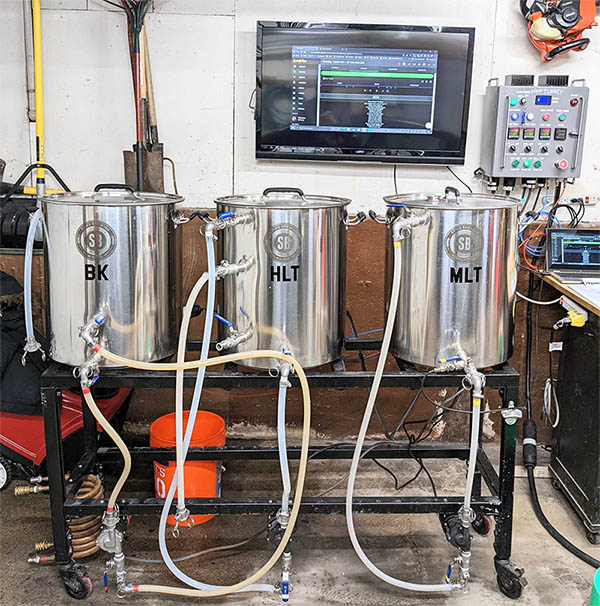 Greg's super sweet brewing setup (check out @hoptuary_brewing on IG).
Greg's super sweet brewing setup (check out @hoptuary_brewing on IG).Note: this is the recipe for 5 gallons, we just tripled everything and made 15 gallons of the base.
Yeast: Omega British Ale V (aka London Ale III)
And this is where it ends for following this recipe. At this point we split the beers into 3 individual fermenters and took them to our homes to ferment.
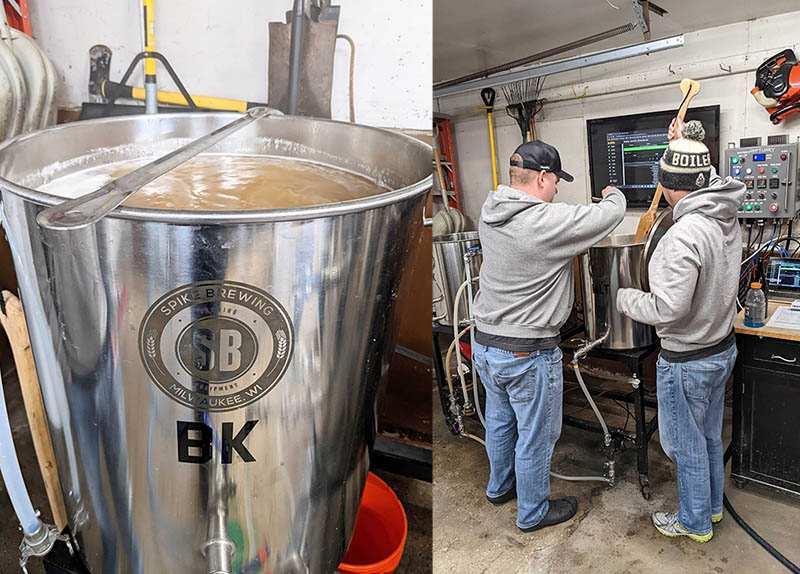 Boil Kettle (aka Burger King) and the two Dads mashing in.
Boil Kettle (aka Burger King) and the two Dads mashing in.Beer #1 - MDH (Mixed Dry Hop): this is the beer that would follow the Tuba Solo original recipe. 2oz of Galaxy before the fermentation finishes, then perform a Diacetyl rest and cold crash to 53F before adding the rest of the hops.
Beer #2 - PFDH (Late Fermentation Dry Hop): this is a beer with a 100% post-fermentation addition. All of the hops were added 1 day after the fermentation has stopped, at 70F.
Beer #3 - CPDH (Cold Post-Fermentation Dry Hop): this is another beer with a 100% post-fermentation addition, but this time at 53F. All of the hops were added 1 day after the fermentation has stopped and the beer was crashed to 53F.
| Beer #1 (MDH) | Beer #2 (LFDH) | Beer #3 (PFDH) | |
| Mid-fermentation | 2oz Galaxy @ Day 5 | ||
| Late fermentation | 3oz Galaxy, 2oz El Dorado, 2oz Mosaic and 1oz Citra on Day 10 | ||
| Post-fermentation | 2oz El Dorado, 2oz Mosaic, 1oz Citra, 1oz Galaxy @ Day 10 | 3oz Galaxy, 2oz El Dorado, 2oz Mosaic and 1oz Citra on Day 10 |
With beers ready, we each bottled 3 bombers of our respective brews and brought them to be evaluated by our homebrew club - Club Wort. The participants were introduced to the beer simply as a NEIPA, and were each poured 3 cups. They were also given a tasting score sheet asking them to rate each of the 3 beers on the following categories:
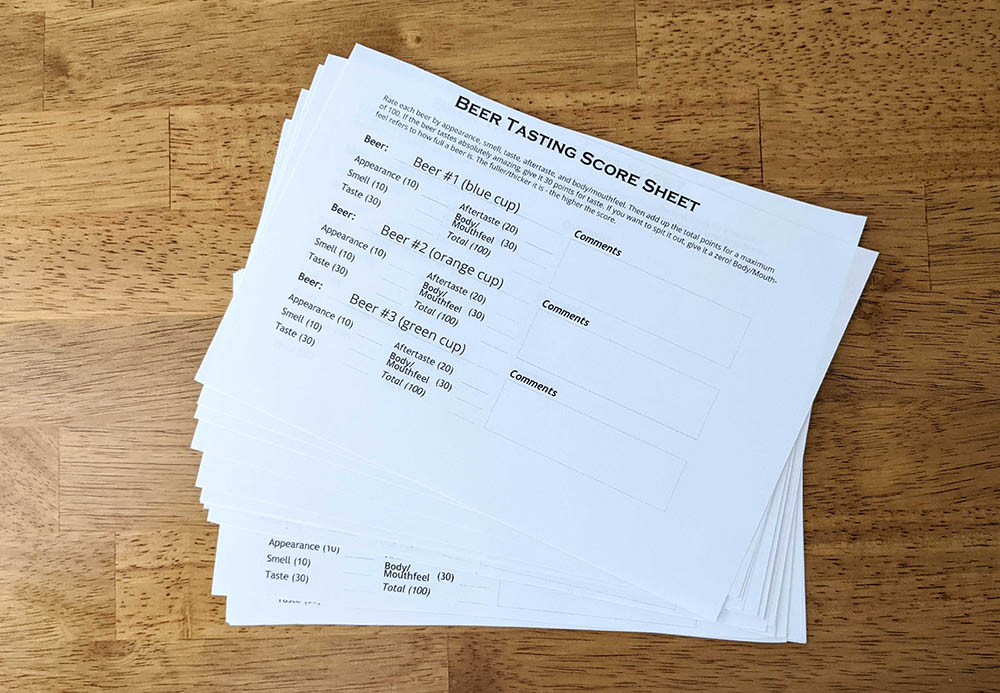 Tasting score sheets
Tasting score sheetsPrior to experiment, I surveyed Reddit as well as my Instagram followers for their preferred dry hopping methods. Here's what was observed:
Dry Hopping Preferences
Out of 118 respondents, most preferred dry hopping method was a mix of mid and post-fermentation dry hopping. Most likely, these brewers are adding hops in the middle or late fermentation, then another dose after fermentation is done. A double dry hop, if you will. Second most popular dry hopping method was adding hops post-fermentation at cold temperatures. This is my own preferred method as it helps to drop out the yeast, reducing hop creep and polyphenol extraction.
One interesting point is that Instagram respondents (n=36) seemed to strongly prefer the post-fermentation (cold) and Mixed dry hopping much stronger than Reddit users. The numbers were overwhelmingly in favor of the two, with only 19% picking the mid-fermentation or post-ferm (room temp) methods.
Reddit was a little more balanced, and also a larger sample size (n=82), while mostly split among the favorite dry hopping methods, the mid-fermentation hopping was the least favored method.
A total of 28 participants took part in the test, all very kind folks of Club Wort in Palatine, IL. The beers were poured into different colored cups to help evaluate the beers purely on flavor and aroma. They were then scored based on a variety of categories, which were then averaged, and given the score out of the total available points. Here are the results:
| Beer #1 (MDH) | Beer #2 (LFDH) | Beer #3 (PFDH) | |
| Aroma | 8.46 | 7.21 | 6.61 |
| Flavor | 20.43 | 18.64 | 18.68 |
| Aftertaste | 13.14 | 13.50 | 13.21 |
| Body/Mouthfeel | 21.54 | 19.61 | 20.25 |
| Total | 71.93 | 67.14 | 66.86 |
| Beer #1 (MDH) | Beer #2 (LFDH) | Beer #3 (PFDH) | |
| Aroma | 84.64% | 72.14% | 66.07% |
| Flavor | 68.10% | 62.14% | 62.26% |
| Aftertaste | 65.71% | 67.50% | 66.07% |
| Body/Mouthfeel | 71.79% | 65.36% | 67.50% |
| Total | 71.93% | 67.14% | 66.86% |
The comments section included some interesting feedback, here are the most common comments for each beer:
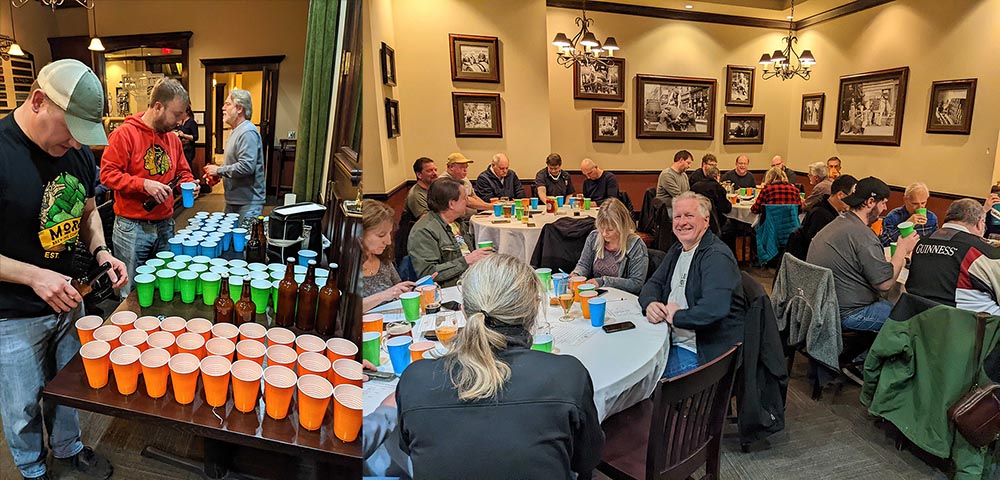 Club Evaluation
Club EvaluationOn top of getting our club's opinions of the three NEIPA's, we each submitted our beers into a big local competition called the Drunk Monk Challenge, where the beers swept the top 3 in the category!
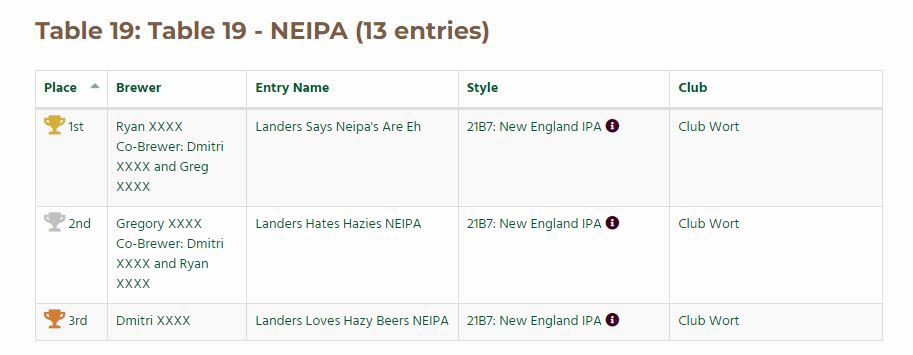 Beer names were an inside joke with the organizers :) I couldn't believe we actually took top 3...
Beer names were an inside joke with the organizers :) I couldn't believe we actually took top 3... Each of the beers got 3 score sheets and these are their average scores for each beer.
| Beer #1 (MDH) | Beer #2 (LFDH) | Beer #3 (PFDH) | |
| Aroma | 10.3 | 10.0 | 9.7 |
| Appearance | 2.7 | 2.0 | 2.7 |
| Flavor | 15.7 | 15.3 | 14.3 |
| Mouthfeel | 4.0 | 3.7 | 4.0 |
| Overall | 7.3 | 8.0 | 7.0 |
| Total | 40.0 | 39.0 | 37.7 |
Despite the scores being in favor of Beer #1 (MDH), Beer #2 was the one that won the Gold medal after the final round of evaluation and comparing these beers side by side. This was the consensus from the judges, despite the final scores.
Beer #1, Mixed Dry Hop additions ranked first in a series of categories, and I'm frankly surprised. Adding Galaxy during fermentation is known to add a significant amount of hop burn, but in this scenario it was the method that produced a beer with the best flavor and aroma. One important note is that this beer used the same bag of hops as Beer #2 (late fermentation dry hop), but not the same bag of Galaxy as Beer #3. That Galaxy AA% had a much higher Alpha Acid percentage (14.6% AA), than the two other beers, which shared the same 8oz package of Galaxy (12.6% AA).
The Post-Fermentation dry hop beer was brewed by me, and it's the first time that I've gotten hop burn in a NEIPA when brewing with this technique. Dropping out the yeast before adding hops is supposed to remedy this, but I firmly believe that my particular lot of Galaxy was particularly high in polyphenol content, thus it had so many hop burn remarks from participants. Honestly, it's not surprising given 14.6% AA.
Interestingly, each of the beers got a comment about some level of hop burn. Admittedly, these beers were served to the Club tasting panel a little young, they were served at around 9 days after the final dry hop. Letting these rest for a couple of weeks has certainly mellowed out the hop burn as tasting these beers now versus before the meeting is day and night.
There are a few variable pollutors that existed in the experiement, and I have to say that we could have done better to eliminate these:
This was a very fun experiment and everyone involved in it won because the beer that we produced is fantastic. Huge notes of canteloupe, honeydew, and pineapple, all on a medium-bodied base and an easy drinking finish.
I would love to try this same recipe without Galaxy and see how other hops impact mid to late-fermentation dry hops, in addition to post-fermentation hops.